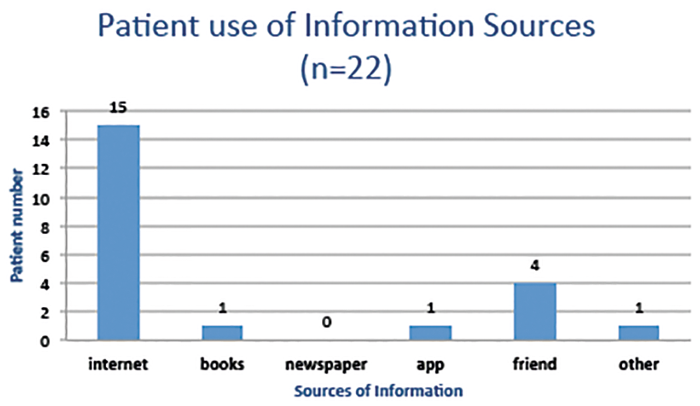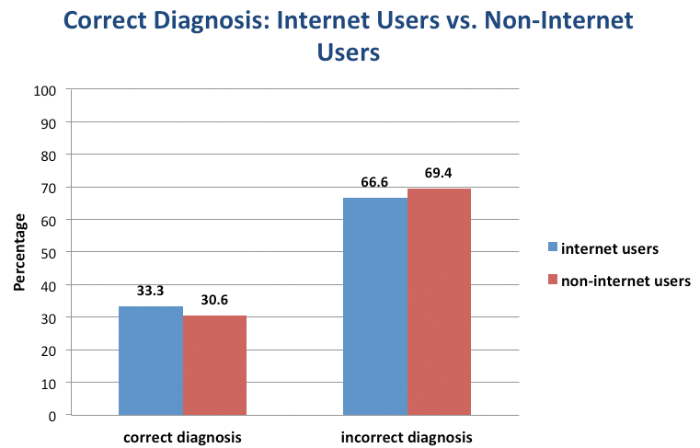All our patients look up their symptoms online before they visit us, don’t they? And patients who do so are better informed than those who don’t, right? Well, that’s not actually the case…
The ‘information era’
More information is now available to patients than ever before. Health information is one of the most frequently searched topics online. Patients regularly use the internet, in particular to research their own symptoms before a healthcare encounter and their diagnosis afterwards [1]. There is now a general understanding that patients have moved from ‘passive recipients’ to ‘active consumers’ of health information and the modern clinician must be equipped to manage the expectations of the ‘internet informed’ patient [1].
There are several tools for assessing the quality of health information online due to the widely accepted notion that health information on the internet has vast variation in accuracy and quality [2].
A recent comprehensive literature review identified 350 studies evaluating the quality of online patient information resources for the common conditions of cardiovascular disease, respiratory disease, cancer, stroke and diabetes [3]. There are far fewer studies, however, concerning patient use of the internet in ENT.
One Southampton study investigated the quality of information in YouTube videos regarding rhinosinusitis [4]. It found that 45% of the videos were useful whereas 27% contained misleading or dangerous information. This contrasts with one Irish study which evaluated 60 websites with information about tonsillectomy, septoplasty and myringoplasty and found that 94% of them contained no inaccuracies [5].
Four studies used questionnaires at five different time intervals to investigate what proportion of patients used the internet as a source of ENT health information [6-9]. Collectively, they found that the proportion of patients using the internet to research ENT health related topics were 16% in 2000, 13% in 2001, 55% in 2006, 37% in 2011 and 30% in 2013.
One 2010 study evaluated 39 tinnitus websites and found the quality of the information to be extremely variable [10].
One Birmingham study investigating whether internet information influenced patient decision found that 51% of acoustic neuroma patients said their care decisions were indeed influenced by the internet [11]. This is the only published paper we are aware of that investigates whether or not ENT patients who research their symptoms online are better informed than those who do not. There is clearly a gap in the literature regarding the extent to which online patient research is helpful in the ENT setting.
A view from North Wales
We designed a prospective questionnaire study to establish a link (if any) between the information sources ENT patients use and how well-informed they are.
A hundred new adult patients attending the general ENT clinic in Wrexham Maelor Hospital were invited to complete a questionnaire.
The questionnaire asked basic demographical questions and crucially:
- ‘What sources of information have you used to investigate your symptoms?’ (with examples)
- ‘Please write down what you think your diagnosis will be today’
The actual diagnosis of the patient was then compared to what their perceived diagnosis was. The study participants were allocated into the following groups:
- Internet users vs. non internet users
- Diagnosis correct vs. diagnosis incorrect
We are pleased to report that 100% of patients completed the questionnaire. The mean age was 56; and 54 participants were male. There was a significant difference (p=0.0084) in the mean age of internet users (45.1) vs. non internet users (57.9).
Surprisingly, of the 100 patients questioned, only 15 had used the internet to research their symptoms (see Figure 1).

Figure 1.
One patient had used a book, one a mobile app, and one a patient information leaflet. Four patients had sought advice from friends or relatives. The vast majority (82) had not researched their symptoms (other than with their GP) at all before attending clinic.
Of the 85 patients who did not use the internet, 30.6% achieved the same diagnosis as the clinician. This is compared with 33.3% of those who did use the internet. There was no statistical significance (p=0.41) in frequency of correct diagnosis between internet users and non-internet users (see Figure 2).
Figure 2.
Online research does not improve patient knowledge
The results show that there appears to be no difference in ENT patient knowledge regardless of whether or not they have researched their symptoms online. Whilst there was a significant difference in age between internet users and non-internet users, there was no significant difference in correct diagnosis between participants older or younger than the mean age of 56. In other words, although younger patients are more likely to use the internet, they are no more likely to be well-informed than older patients.
This is a single centre study and is, therefore, open to population bias. All patients lived in the catchment area of a North Wales DGH serving a broad variety of areas and socioeconomic class. Perhaps a similar study in an inner city hospital may yield different results.
This study also directly correlates how ‘well-informed’ a patient is with whether or not they knew their diagnosis. There may be better methods to test how well-informed patients are but we believe that a patient knowing their diagnosis is a good representation of how well they have interpreted the information available to them.
A wider context
There are more online information sources for patients than ever before. There is huge financial and political investment in developing online platforms for patient use. However, despite living in an ‘information age’, our study population displayed a relatively low use of the internet for researching healthcare. Furthermore, there was no difference between how well-informed internet users were than those who do not research their health online. In spite of these results, we acknowledge that a well-informed patient is essential for making shared healthcare decisions. We would suggest that it is our responsibility as clinicians to direct patients towards quality, reliable healthcare information in whatever medium they find most useful.
References
1. McMullan M. Patients using the Internet to obtain health information: how this affects the patient-health professional relationship. Patient Educ Couns 2006;63(1-2):24-8.
2. Hanif F. Read JC, Goodacre, JA, et.al. The role of quality tools in assessing reliability of the Internet for health information. Informatics for Health and Social Care 2009;34(4).
3. Wildevuur SE, Simonse LW. Information and communication technology-enabled person-centered care for the “big five” chronic conditions: scoping review. J Med Internet Res 2015;17(3):e77.
4. Biggs TC, Bird JH, Harries PG, Salib RJ . YouTube as a source of information on rhinosinusitis: the good, the bad and the ugly. J Laryngol Otol 2013;127(8):749-54.
5. Kulasegarah J, Harney M, Walsh M, Walsh RM. The quality of information on three common ENT procedures on the Interent. Ir J Med Sci 2012;181(2):221-4.
6. Glynn RW, O’Duffy F, O’Dwyer TP, et al. Patterns of Internet and Smartphone use by parents of children attending a paediatric otolaryngology service. Int J Pediatr Otorhinolaryngol 2013;77(5):699-702.
7. Trotter MI, Morgan DW. Patients’ use of the Internet for health related matters: a study of Internet usage in 2000 and 2006. Health Informatics J 2008;14(3):175-81.
8. Rokade A, Kapoor PK, Rao S, et al. Has the internet overtaken other traditional sources of health information? Questionnaire survey of patients attending ENT outpatients clinics. Clin Otolaryngol Allied Sci 2002;27(6):526-8.
9. Shaw B, Farboud A, Trinidade A, Kothari P. Internet and e-mail use in ENT: a survey of patient usage and satisfaction. Eur Arch Otorhinolaryngol 2012;269(3):1051-4.
10. Kieran SM, Skinner LJ, Donnelly M, Smyth DA. A critical evaluation of Web sites offering patient information on tinnitus. Ear Nose Throat J 2010;89(1):E11-4.
11. Orabi AA, D’Souza AR, Walsh RR, Irving RM. The influence of the Internet on Decision making in aucoustic neuroma. J Laryngol Otol 2005;119(10):806-9.
Declaration of competing interests: None declared.






